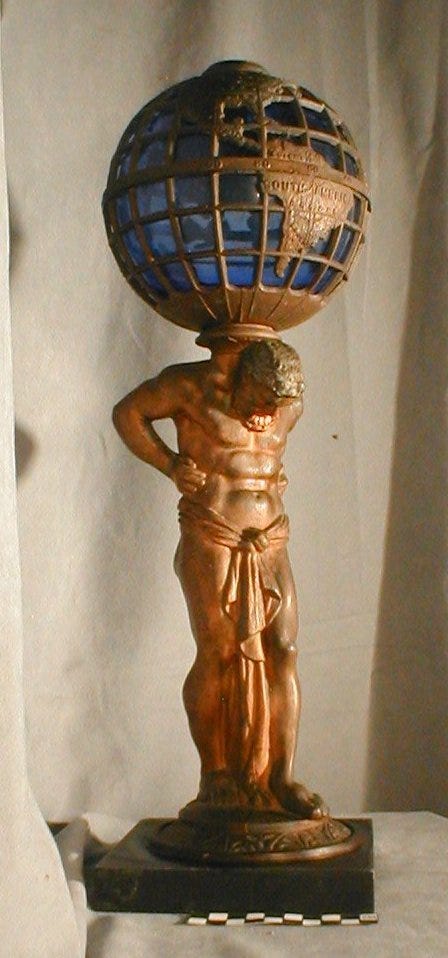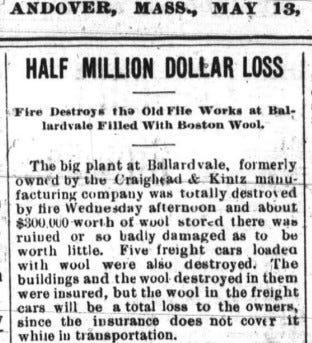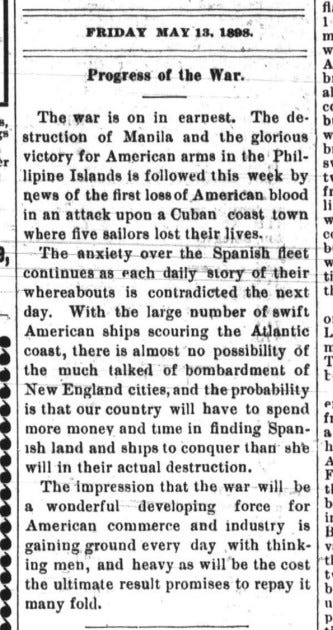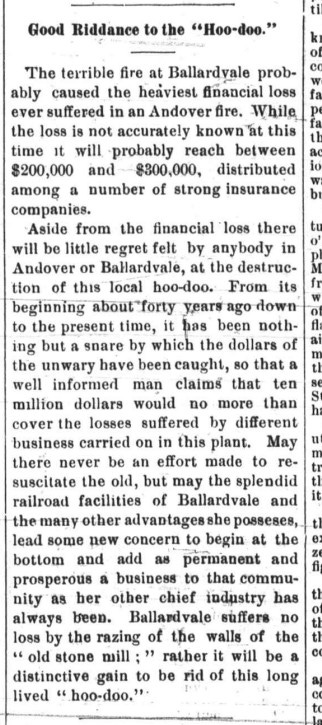Miscellany Mondays: Is it coincidence when the fire breaks out three days after the policy is written? You decide!
The Craighead & Kintz factory building has a fascinating history that includes the possibility of arson, insurance fraud, fears over the short-lived Spanish American War, and – dare I say – “hoo-doo.”
In the next few weeks, we’ll start to offer special benefits for paid History Buzz subscribers. It’ll be a limited number of posts and we’ll roll it out slowly. No surprises. We’ll let you know when you’ll encounter the first paywall. All that said, it’s important to us that all our subscribers - paid and free - know how much you mean to us. You’re what makes History Buzz special! Thank you all!
Back in October 2021, What’s It Wednesday writer Marilyn Helmers wrote a post on this lamp in the History Center’s collection. Do you remember it?
It’s one of my favorite curiosities in the collection. We featured it at a fundraising event back in pre-pandemic days. The beautiful deep blue of the globe struck me. Isn’t it stunning?
As usual, there’s a story behind the story
Marilyn’s post, which you can read here, ended with a question mark. We’re not really sure if the lamp was made in Andover by Craighead & Kintz.
But we do know that the Craighead & Kintz factory building has a fascinating history that includes the possibility of arson, insurance fraud, and fears over the short-lived Spanish American War.
Ballardvale Mill
The mill building was built in 1847 by local manufacturer John Marland to house the Ballard Vale Machine Shop. Several engines for the Boston & Maine Railroad were constructed in the Ballardvale1 factory.
After the machine shop, the mill was home to a rubber manufacturer and then in 1855 the Whipple File Company. Whipple File closed in 1869 and the mill was vacant for 14 years until Craighead & Kintz took ownership in 1883.
The number of business that operated out of the mill is part of the building’s fascinating story. Over 22 years, between 1847 and 1869, the building was home to three manufacturers – machine shop, rubber manufacturer, and a file company. Then it was vacant for 14 years.
Craighead & Kintz
In 1883, the Connecticut-based firm Craighead & Kintz moved some of its manufacturing to what was known as the old Whipple File Company in Ballardvale.
Craighead & Kintz was well known for its decorative, artistic bronze plaques, and lamps. They had showrooms in New York City and published catalogs of their products. As influential as the company was in the history of Ballardvale, Craighead & Kintz didn’t have a long history here.
Times, tastes, and technology were changing and the large bronze kerosene lamps were going out of style. The growing use of electricity had a major impact on the company, which was struggling.
Lightning strikes
In September 1895, the Craighead & Kintz factory was hit by lightning. The strike and fire completely destroyed $4,000 worth of finished goods that were ready to be shipped the following day. Shortly after the lightning strike and closure, a new company attempted to carry on with production, but that effort failed and the mill building was shut down again.
The factory building was gaining an unfavorable reputation in town.2
Another indication that the plant was hoodooed is shown by the fact that the structure was hit by lightning and in 1895 and partially burned.
The story continued . . .
Three years after the lightning strike that ended Craighead & Kintz, the factory building came to a dramatic end.
On May 11, 1898 a catastrophic fire demolished the mill and five train freight cars parked alongside the mill.
Fire fighters from Ballardvale, Andover, and Lawrence worked to keep the fire from spreading beyond the 2 acres that made up the mill site.
The fire started about 12:30p.m. in a pile of timber and rubbish near the wall of the southeast end of the main building. The flames quickly caught in the bales of wool in the building and then spread with amazing rapidity until the whole main building was a mass of flames. A general alarm was sounded at 1 o’clock and the entire Andover department responded. The Ballardvale Hose wagon was early on the scene and the Andover steamer arrived in short order, but the flames were beyond control and all that could be done was to prevent the conflagration from spreading to adjoining buildings, and the Bradlee mills nearby.
A fresh southwesterly breeze was blowing and the flames soon swept over the entire plant, which covers two acres of ground. The train of five freight cars was side tracked directly in line with the flames and all the cars were gutted before the fire was under control.
Connection with the Spanish-American War
The 10-week Spanish-American War had been declared on April 21, 1898, just a few weeks before the fire broke out.
With the large number of swift American ships scouring the Atlantic coast, there is almost no possibility of the much talked of bombardment of New England cities, and the probability is that our country will have to spend more money and time in finding Spanish land and ships to conquer than she will in their actual destruction.
Bombardment insurance
However much public opinion might have held that the war held no danger to east coast cities, insurance companies charged “bombardment insurance” to businesses located near the coast.
Whether is was fear of bombardment, or an attempt to avoid buying bombardment insurance, companies sought inland locations to store their goods.
At the time of the May 11, 1898 fire, the Ballardvale mill building was being used for temporary wool storage by a number of companies including Dennis Bros. & Lovejoy company of Boston, Messrs. Hecht, Leibmann, & Co., J. Koshland & Co., and Eisemann & Co.
All claimed that they had moved their wool supply away from Boston harbor to the empty Ballardvale mill for safe-keeping. Each company insured their goods against loss while in temporary storage in Ballardvale.
Coincidentally, according to the Townsman newspaper, several insurance inspectors were already in Ballardvale on May 11th to inspect the risk of covering the policies taken out just a few days prior, when the fire broke out.
Having finished their inspections, they went toward the depot, but the fire occurred before the train went out, and they turned back to witness the destruction of the risk they had just inspected.
The Townsman reporter seemed to enjoying this reported, writing that,
They modified their reports as to the desirability of the risk when they left the mill a second time.
Many in the community suggested the fire might not have been accidental.
The Andover Townsman estimated that insurance losses came to between $200,000 and $300,000. The newspaper reported that,
The insurance was placed on May 8, dated May 10, and became a claim on May 11. The policies were for the most part very large, on the building (which) was considered ridiculously small, and there is a great deal of subdued excitement in insurance quarters in consequence.
No other reports on the fire, or status of the insurance claims appeared in the Andover Townsman after May 13, 1898. It could all be just a good bit of local gossip - which the Townsman had a flair for - but the coincidences do keep piling up.
Good Riddance to the “Hoo-doo”
According to an opinion piece in the Townsman, again on May 13, 1898, many in Ballardvale were happy to see the factory building and its “Hoo-doo” gone.
I hope you enjoyed today’s story! It is another my favorites. Please like, share, leave a comment, and - if you’re not a subscriber yet - please subscribe.
Thanks for reading,
~Elaine
Ballardvale is in the southern part of Andover. One of the town’s three industrial districts, Ballardvale hugs both sides of the Shawsheen River. You can read a short introduction to this part of town here. Scroll down past the information on the historic district to get to the history, https://preservation.mhl.org/ballardvale-historic-district.
Andover Townsman, May 13, 1898, multiple articles about the fire appeared in this issue of the newspaper. You can read it online on the Memorial Hall Library website, https://mhl.org/sites/default/files/newspapers/ATM-1898-05.pdf.











Sometimes, things are a little bit Too Much of a coincidence. I doubt that insurance fraud was involved if the goods belonged to more than one company.
Very interesting and a great presentation. Wonder if "hoo-doo" had hoodoo in mind? An interesting lookup. From one of the newspaper clips Ballardvale also seems to have had a rail yard or railroad facility worthy of mention.